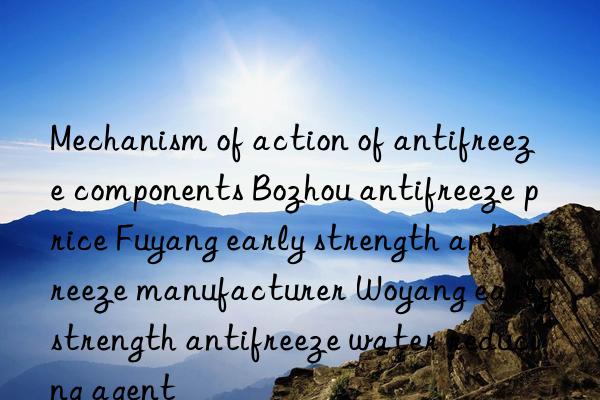
Antifreeze is a type of admixture, consisting of water-reducing components, air-entraining components, antifreeze components, and sometimes early-strength components.
1 Water-reducing component
The main function of the water-reducing component is to reduce water. Water-reducing agents have three effects on concrete in winter: first, reducing water means increasing strength, which means improving the frost resistance of concrete; second, reducing water consumption when the salt content is certain, increasing the concentration of salt in free water in concrete , and the refining effect of its pores further reduces the liquid freezing point, which is conducive to the hydration reaction and improves the early strength; third, it reduces the frost heaving force caused by water freezing on concrete, by about 20~ per cubic meter of concrete. 50L of water increases the density of concrete, greatly reduces the freezing damage caused by free water to concrete, and refines the capillary pores, which still promotes the reduction of the liquid freezing point.
2 Air-entraining components
In the concrete mixture, add tiny sealed bubbles This method makes the bubbles act like rolling balls, reducing their viscosity, reducing the friction between the concrete and the pipe wall, increasing the lubricity during the construction stage, and at the same time improving the internal pore structure of the concrete after hardening, which can slow down the frost heaving force of ice crystals. This reduces damage to the internal structure of concrete and greatly improves the frost resistance of hardened concrete.
3 Antifreeze component
Antifreeze component refers to a component that makes the concrete mixture at negative temperatures Chemicals that are not susceptible to freezing damage in the environment. There are many inorganic salts and some organic substances that have antifreeze functions, and their modes of action can be divided into three categories: one is that they have a very low eutectic temperature with water. They can lower the freezing point of water so that concrete can still undergo freezing at negative temperatures. Chemical effects, such as sodium nitrite and sodium chloride. However, once the dosage is insufficient or the temperature is too low, freezing damage will still occur. The other type can not only lower the freezing point of water, but also seriously deform the crystal lattice structure of ice containing such substances, so that it cannot form frost heave stress and destroy the hydrated mineral structure and damage the strength of concrete, such as urea and methanol. When the dosage is insufficient, the strength stops growing at negative temperature, but it has no effect on the final strength after turning to positive temperature; the third category is that although the aqueous solution has a very low eutectic temperature, it cannot significantly reduce the freezing point of water in concrete. Its Its function is to directly react with cement to accelerate the setting and hardening of concrete. It is beneficial to the development of concrete strength, such as calcium chloride and potassium carbonate.
4 Early Strength Components
Although the trace catalytic early strength component does not participate in the water content of cement chemical reaction, but it can play a catalytic role, which can accelerate the process of hydration of minerals in cement to form calcium vanadium, so that the concrete can form a strength skeleton in a short time, reach the critical frost resistance strength as soon as possible, and enhance the ability of the concrete to withstand frost damage. , More importantly, the acceleration of the early hydration reaction can turn most of the free water in the concrete into non-freezing combined water, thereby reducing the freezing damage of the concrete.
2. 5 Other components
For powder admixtures, they can also be used in concrete mixtures Add cohesive mineral powder. Because mineral fine powder and ultra-fine powder mixed materials are compounded with antifreeze, they can not only give the concrete a certain antifreeze ability in the early stages of curing, but also significantly reduce the number of pores inside the concrete.

 微信扫一扫打赏
微信扫一扫打赏

